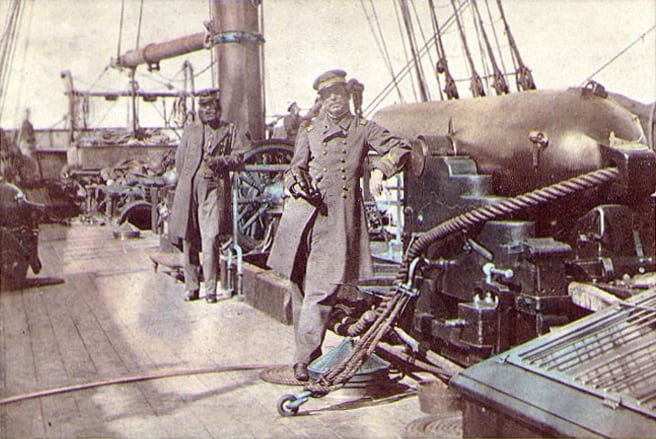January 4, 1863 – January 17, 1863

Captain Raphael Semmes (center) and First Lieutenant John Kell (left) aboard CSS Alabama in 1863. U.S. Naval Historical Center photograph, original photograph by an unknown photographer.
By Phil Kohn
Phil Kohn can be reached at USCW160@yahoo.com
Political appointee Maj. Gen. John McClernand — upset that he hadn’t been named to command the assault against Vicksburg (which failed) that had been led by Maj. Gen. William T. Sherman — on January 4, 1863, begins moving 30,000 Federal troops in an unauthorized expedition up the Mississippi River. His goal: the taking of Confederate Fort Hindman at Arkansas Post, Arkansas, on the Arkansas River.
Confederate partisan raiding in Missouri resumes on January 7. Brig. Gen. John Marmaduke, with 2,300 cavalrymen, captures Ozark but is unable to make headway against Federal troops and local militia under Brig. Gen. Egbert Brown at Springfield.
On January 9, the (Confederate) Missouri Cavalry Brigade, under Col. Joseph Porter, takes Hartsville, about 50 miles east of Springfield. In the Florida Panhandle, Federal sailors raid and damage a Confederate salt works at St. Joseph, on the shore of the Gulf of Mexico, roughly midway between Tallahassee and Pensacola.
On January 10, Maj. Gen. Ulysses S. Grant arrives in Memphis after pulling back from Grenada, Mississippi, following the Confederates’ destruction of his supply depot at Holly Springs. Of necessity, his force of 103,000 troops has had to live off the land, and it is an eye-opening revelation to Grant that it can be done. In Washington, D.C., a court-martial sentences Maj. Gen. Fitz-John Porter to dismissal from the army for failure to follow orders at the Battle of Second Manassas in August 1862. (Porter spends years trying to clear his name. Finally, in 1879, after a review of the circumstances, the sentence is overturned. However, it takes seven more years, until 1886, for Porter to be recommissioned as a colonel, but with back-pay denied. Two days later, he resigns from the army.) In Arkansas, Confederate Fort Hindman, at Arkansas Post, is surrounded by the Federal force of Maj. Gen. John McClernand.
On January 11, Gen. Braxton Bragg sends a circular to his subordinate generals asking for their support. The responses make clear that he does not have it, nor will he get it. On the same day, about 20 miles off Galveston, Texas, CSS Alabama, under Capt. Raphael Semmes, duels the Federal blockading ship USS Hatteras and sinks her. Not only is it the closest that Alabama will ever get to the Confederacy, but it is also the first time a steamship sinks another steamship in battle. In Arkansas, Maj. Gen. John McClernand’s roughly 30,000 Federal troops capture Fort Hindman, defended by around 5,500 Confederates. U.S. casualties: 134 killed, 898 wounded, 29 missing. Confederate casualties: 28 killed, 81 wounded, 4,720 taken prisoner.
Federal officials on January 13 formally authorize the raising of black troops for service in the South Carolina Volunteer Infantry. From Columbia, in south central Tennessee, Confederate Brig. Gen. Joseph Wheeler leads his cavalry in raids against Harpeth Shoals and Ashland, in the northern portion of the state.
The Confederate sloop-of-war CSS Florida, commanded by Capt. John Maffitt, early on January 16 slips past the Union blockading squadron and sails out of Mobile Bay, Alabama, into the Gulf of Mexico. The vessel will capture and destroy 15 U.S.-flagged ships before being captured in Brazil in 1864.







